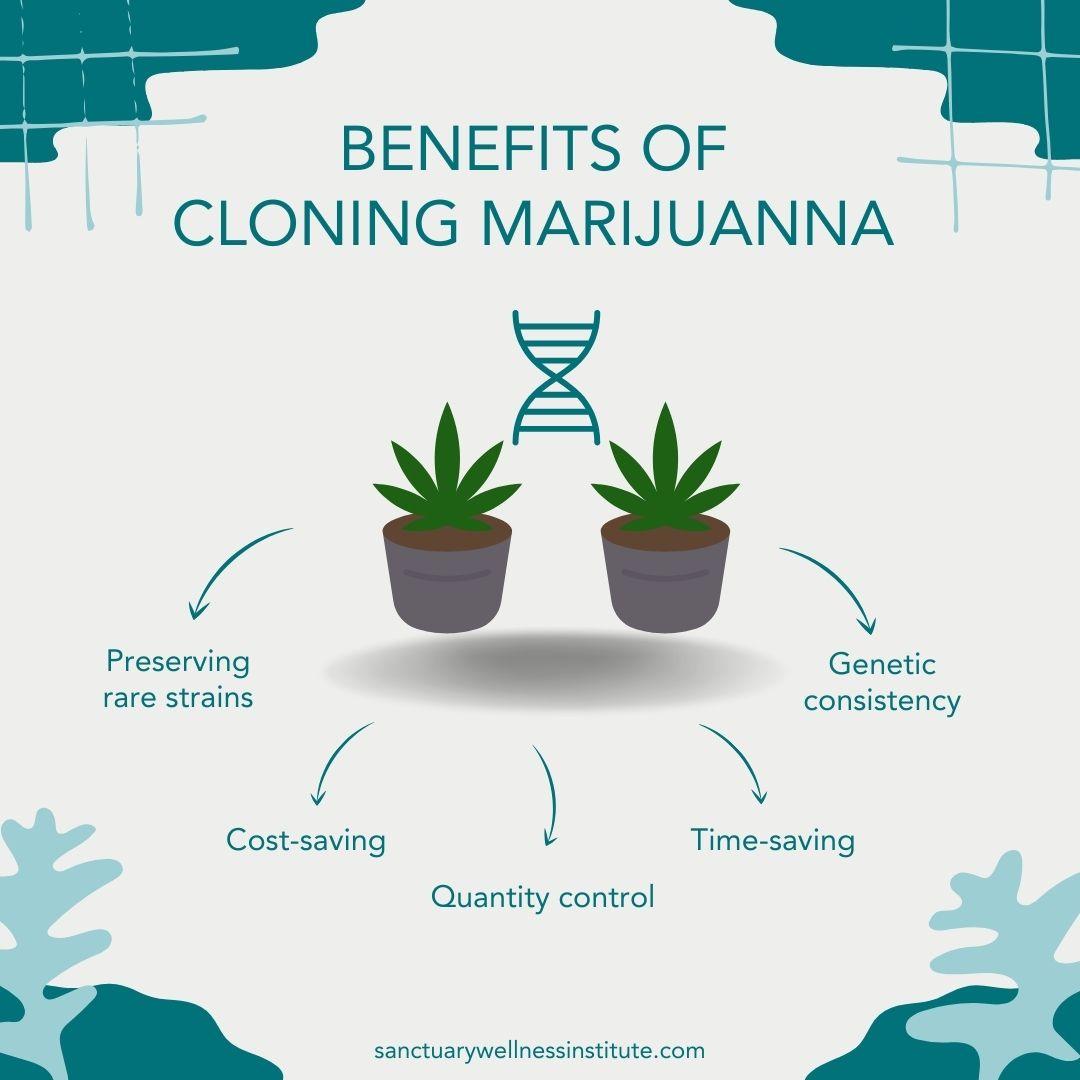- Jake Peter
- Published: December 9, 2021
- Updated: August 21, 2024
- Fact-checked by Dr. Desiree Granados

Cloning cannabis plants is a popular technique among growers, as it allows them to replicate their favorite strains and maintain genetic consistency. This method involves taking a cutting from a mother plant and rooting it to create an exact genetic copy. In this guide, we will walk you through the steps of how to successfully clone your cannabis plants.
Benefits of Cloning Cannabis at Home
Before we dive into the cloning process, let’s first discuss some of the benefits of cloning cannabis at home. Cloning allows you to create genetically identical plants, ensuring consistent quality and characteristics in your harvest. It also saves you money, as you won’t need to purchase new seeds for each growth cycle.
Furthermore, cloning can significantly speed up the cultivation process, giving you the opportunity to produce multiple plants in a shorter time frame. Plus, cultivating clones from your best plants allows you to preserve and enhance your favorite strains. Overall, home cloning can be a rewarding and efficient way to enhance your cannabis gardening experience.

Cloning cannabis at home offers several benefits, including:
- Cost-saving: Cloning allows you to create new plants without having to purchase seeds or spend money on new genetics.
- Genetic consistency: By cloning a mother plant, you ensure that each new plant will have the same desirable traits and characteristics as the original.
- Time-saving: Cloning can save growers time by eliminating the germination process and reducing the time it takes for a plant to reach maturity.
- Quantity control: With cloning, you have complete control over how many plants you want to produce. This is especially useful for those who may have limited space or are growing for personal use.
- Preserving rare strains: If you have a rare or hard-to-find strain that you want to keep in your garden, cloning is an excellent way to ensure its continued existence.
Finally, remember to look into your state and local laws regarding cannabis cultivation, as not all regions legally permit home growing. You can learn more about marijuana laws in each state by checking out our “Marijuana Laws by State” resource page.
Equipment Needed for Cloning Cannabis
To successfully clone cannabis at home, you will need a few essential tools. These include:
- Mother plant: Choose a healthy and robust mother plant from your existing garden to take cuttings from.
- Razor blade or sharp scissors: A clean and sharp cutting tool is crucial for making precision cuts on your mother plant.
- Rooting hormone: This helps stimulate root growth in the new clones and increases their chances of survival.
- Cloning gel/powder: Similar to rooting hormone, cloning gel or powder can also promote root development in the new clones.
- Starter cubes/pots: You will need a medium to place your clones in while they develop roots. Rockwool cubes or peat pellets are popular choices for starting clones.
- Humidity dome: A humidity dome can help create a moist and humid environment for your new clones to thrive in.
- Grow light: Since the new clones will not have developed roots yet, they will need supplemental light to continue growing.
- Spray bottle: You will need a spray bottle filled with water to mist your clones and keep them hydrated during the initial rooting stage.
Step-by-Step Instructions for Cloning Cannabis

Now that you have all the necessary equipment, let’s dive into the cloning process. Follow these steps to successfully clone your cannabis plants:
- Select a healthy mother plant: Choose a well-established and healthy mother plant with desirable traits that you want to replicate.
- Prepare your cutting tool: Make sure your razor blade or scissors are clean and sharp to make precise cuts on the mother plant.
- Identify a suitable stem for cloning: Look for a young, green, and pliable stem on the mother plant without any flowers or budding sites.
- Take the cutting: Cut at a 45-degree angle just below a node (where leaves emerge) on the chosen stem. The cutting should be around 4-6 inches long with at least two sets of leaves.
- Trim the cutting: Remove any large fan leaves from the lower half of the cutting, leaving only a few small leaves near the top.
- Dip in rooting hormone and place in starter cubes/pots: Dip the end of your cutting in rooting hormone and then place it into a moistened starter cube or pot filled with a growing medium.
- Place humidity dome over clones: Once all your cuttings are planted, cover them with a humidity dome to create a moist and humid environment for root development.
- Provide supplemental light: Since the clones do not have developed roots yet, they will need extra light to continue growing. Place them under a grow light for 16-18 hours per day.
- Mist clones regularly: Use a spray bottle to mist the clones and keep them hydrated during the rooting stage.
- Transplant into larger pots: Once your clones have rooted and developed at least one inch of new growth, you can transplant them into larger pots with soil or another preferred growing medium.
- Continue regular care and maintenance: Treat your new clones as you would any other cannabis plant by providing proper lighting, watering, and nutrients.
- Repeat the process: You can continue cloning from your newly rooted plants to create even more genetically identical copies.
Conclusion
Cloning cannabis is a cost-effective and efficient way to enhance your gardening experience. With the right equipment and techniques, you can successfully clone your favorite plants and create a consistent supply of high-quality cannabis. Remember to always label and keep track of your clones to ensure genetic consistency in future harvests.
The benefits of home cloning extend beyond just cost-saving and genetic consistency. It also allows for experimentation and innovation in your garden. By creating multiple genetically identical plants, you have the opportunity to try different growing techniques or alterations in environmental conditions. This can lead to new discoveries and improvements in your cannabis cultivation process.
States Where We Offer Medical Marijuana Card Services
- Pennsylvania
- Florida
- Arkansas
- Connecticut
- Maryland
- Michigan
- Oklahoma
- West Virginia
- Ohio
- Virginia
- Missouri
Frequently Asked Questions
At what stage do you clone cannabis?
It is best to take cuttings from a mother plant during the vegetative stage when it is actively growing and has not yet started flowering. This ensures that the clones will have a higher chance of survival and develop into healthy plants.
Does cloning ruin cannabis?
No, cloning does not ruin cannabis; rather, it is a well-established and natural practice in horticulture that has been utilized for centuries. Cloning allows growers to produce genetically identical plants, ensuring consistency in traits such as potency, flavor, and growth characteristics.
How fast can cannabis clones root?
On average, cannabis clones typically take about 7 to 14 days to develop roots. However, this rooting period can vary significantly based on several factors. Environmental conditions such as temperature, humidity, light intensity, and airflow play crucial roles in the cloning process.
How we reviewed this article:
- FloraFlex (2023) THE BENEFITS OF USING CANNABIS CLONES IN YOUR GARDEN
https://floraflex.com/UK/blog/post/the-benefits-of-using-cannabis-clones-in-your-garden - Jose Leme, Spencer Schuchman, Kaitlin Creager, Amy Boren, and Karla Gage (2024) Protocol for Cannabis Cloning
https://opensiuc.lib.siu.edu/cgi/viewcontent.cgi?article=1094&context=psas_articles
Current Version
August 21, 2024
Written By
Jake Peter
Fact-checked By
Dr. Desiree Granados
Editorial Process
Our Editorial Process
First Published
December 9, 2021
Written By
Jake Peter
Fact-checked By
Dr. Desiree Granados
Editorial Process
Our Editorial Process

Jake Peter received his journalism degree from Emerson College and has been writing content for the Sanctuary Wellness Institute since 2021. He is passionate about all things cannabis.







